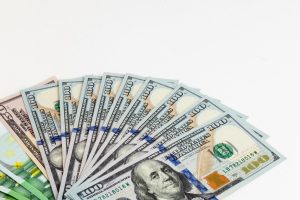DOLLAR SLIPS ON FED CREDIBILITY CONCERNS, EURO CLOSE TO 4-YEAR HIGH
The dollar slipped to multi-year lows against the euro and Swiss franc on Thursday as concerns about the future independence of the U.S. Federal Reserve undermined faith in the soundness of the country’s monetary policy. According to a Wall Street Journal report, U.S. President Donald Trump had toyed with the idea of selecting and announcing Federal Reserve Chair Jerome Powell’s replacement by September or October, aiming to undermine his position. “From a market perspective, of course, not only does that undermine the Fed’s credibility and independence, clearly, (but) it’s a risk to the outlook for U.S. rates as well,” said Nick Rees, head of macro research at Monex Europe. “Those concerns weigh on the dollar this morning,” Rees said, adding that pressure on the currency from Trump team’s rhetoric could intensify ahead of the expiry on July 9 of “reciprocal tariff” suspensions with trading partners including the European Union. Trump called Powell “terrible” on Wednesday for not lowering interest rates sharply, while the Fed Chair was telling the Senate that policy had to be cautious as the president’s tariff plans were a risk to inflation. Markets have nudged up the chance of a rate cut at the Fed’s next meeting in July to 25%, from just 12% a week ago, and are pricing in 64 basis points of cuts by year-end, up from around 46 basis points last Friday. The dollar was under broad pressure as the euro gained 0.6% to $1.1729, its highest since September 2021. Sterling rose 0.65% to $1.3753, its highest since October 2021, while the dollar was at its lowest in more than a decade on the Swiss franc at 0.7983. The franc also struck a record peak on the yen around 180.55 overnight. However, the safe-haven Japanese currency was strengthening across the board after losses in the previous session. “From a yen perspective, traders are just looking for next steps from the Bank of Japan,” Rees said. “We think (the rate path) is going to be fairly moderate, but we do think it supports sustained yen appreciation in the medium term.” After raising short-term interest rates to 0.5% in January, the Bank of Japan has signalled readiness to raise rates further. However, its policymakers called for keeping interest rates steady for the time being due to uncertainty over the impact of U.S. tariffs on Japan’s economy, a summary of opinions at the bank’s June policy meeting showed on Wednesday. The greenback lost nearly 1% on the yen to 143.91, while the dollar index sank to its lowest since early 2022 at 97.09. Trump’s chaotic tariff policies are also coming back into focus as the clock ticks down to his July 9 deadline for trade deals. JPMorgan on Wednesday warned the hit from tariffs would slow U.S. economic growth and lift inflation, resulting in a 40% chance of a recession. “The risk of additional negative shocks is elevated, and we expect U.S. tariff rates to move higher,” JPMorgan analysts said in their report. “The upshot of these developments is that our baseline scenario incorporates the end of a phase of U.S. exceptionalism.” The ending of “exceptionalism” has been a major theme in the dollar’s decline in recent months, as investors question its dominant reserve currency status and as the main safe haven among currencies.

STERLING RISES AS RISK ASSETS RALLY ON ISRAEL-IRAN CEASEFIRE
Sterling climbed against the euro and the dollar on Tuesday, lifted by a rally in risk assets after U.S. President Donald Trump announced a ceasefire between Israel and Iran. Israeli Defence Minister Israel Katz said on Tuesday he had ordered the military to strike Tehran in response to what he said were missiles fired by Iran in a violation of the truce deal. Iran denied violating it, saying there had been no launch of missiles towards Israel in recent hours. During times of global uncertainty, investors often retreat from sterling – viewed as a risk-sensitive currency – in favour of traditional safe havens such as the Swiss franc, Japanese yen and, more recently, the euro. The single European currency fell 0.40% to 85.23 pence. It hit 85.74 pence on Monday, its highest level since April 23. The safe-haven status of the dollar has been under scrutiny on concerns over U.S. fiscal policy, and potential shifts in global reserve currency preferences. The pound was up 0.55% versus the greenback at $1.3601. It hit $1.36325 last week, its highest level since February 2022. Recent soft economic data and a more dovish tone from the Bank of England have also pressured the British currency. Analysts said the BoE’s vote last week to keep rates steady – with three dissenters in favour of cutting them immediately – suggests that the Monetary Policy Committee is becoming increasingly concerned with the growth outlook and the performance of Britain’s labour market. British business activity expanded modestly but employers cut jobs more quickly, according to a survey released on Monday. “Rate setters view the current policy stance as restrictive and are ready to ease as inflation pressures fade, but we must be prepared for this to take time,” said Dean Turner, chief euro zone and UK economist at UBS Global Wealth Management’s Chief Investment Office. “We expect the BoE to stick with its quarterly cadence of cuts and deliver 25 bps reductions at its August and November meetings, taking the base rate to 3.75% by year-end.”
STERLING HOLDS FIRM NEAR JANUARY 2022 HIGHS
The pound held steady against the dollar on Wednesday, consolidating gains from the past two days, as investors felt confident enough in the fragile ceasefire between Israel and Iran to dip into more volatile assets. Sterling has risen by 1.3% against the dollar so far this week, marking its largest three-day gain since late April. It was last flat at $1.361, near its highest since early 2022. The pound held firm against the euro, which traded at 85.29 pence, not far off this week’s two-month highs. The pound tends to be more volatile than the euro or the yen and, as such, can often fall more sharply when investor mood turns sour. In the last 12 days, sterling has gained just 0.3%, compared with a rise of 0.6% in the value of the safe-haven Swiss franc. On the geopolitical front on Wednesday, the ceasefire brokered by U.S. President Donald Trump between Iran and Israel appeared to be holding, a day after both countries signalled that their air war had ended. On the macroeconomic front, surveys showed Britain’s labour market was showing further signs of slowdown, which pointed to below-inflation pay growth and a fall in job vacancies, especially for graduate-level jobs. Bank of England Governor Andrew Bailey on Tuesday said there were now signs that Britain’s labour market was softening, and he repeated his view that interest rates were likely to continue falling. Money markets show traders see an 80% chance of a rate cut from the BoE in August. BoE monetary policymaker Megan Greene, who voted to leave rates unchanged at the most recent meeting, said on Tuesday the recent increase in UK inflation could prove to be a longer-lasting plateau rather than a short-term hump, and the central bank should be wary of cutting borrowing costs. One factor that analysts at Monex say markets are overlooking is a brewing rebellion among lawmakers of Prime Minister Keir Starmer’s Labour party over his proposed reforms to the welfare system. In what would be a major blow to Starmer a year after he won a large majority in parliament, Labour lawmakers have spearheaded an effort to kill the government’s welfare plan at a vote due next week, saying it failed to provide support for disabled people and those with long-term health conditions. “The implication is that substantial tax rises or additional borrowing would be needed come the autumn, if the government cannot pass reforms to limit spending on entitlements,” Monex analysts said in a note.”And that is not a sterling-positive dynamic if similar recent episodes are anything to go by,” they said, warning of “growing downside risks” for sterling. BoE Deputy Governor Clare Lombardelli is due to speak later on Wednesday.
DOLLAR PLUNGES AS TRUMP PUMMELS POWELL
The dollar’s index against the most traded world currencies has now lost more than 10% in 2025 to date just as the half-year mark approaches next week, and it is now at its weakest in three years. That is the index’s worst six-month performance since 1991, and it is its worst first half since the start of the floating exchange rate era 52 years ago. The euro soared above $1.17 to its highest in almost four years, the Swiss franc hit its strongest in a decade and sterling hit its best level since 2021. The dollar slide has snowballed since Trump’s trade war unfolded in April amid worries about foreign investor flight and uncertainty about U.S. policymaking. A revival of Europe’s economic outlook has been the flipside, spurred by a ratcheting up of regional defense spending and Germany’s dramatic fiscal boost. Wary of the inflationary effects of tariff increases, the Fed has held the line on interest rates while other central banks continued easing. But speculation about a resumption of rate cuts this year has mounted again this month – with particular focus on what happens after Fed Chair Powell’s term ends next May. The trigger for the overnight dollar lurch lower appears to have been Trump’s latest salvo against Powell and his reluctance to back a rate cut now – a stance the Fed boss underlined in congressional testimonies this week. But attending the NATO summit in The Hague on Wednesday, where the alliance pledged to lift defense spending toward 5% of GDP over the next decade, Trump said he would soon name his picks to replace what he called a “terrible” Powell next year. With splits emerging among the Fed policymakers about how soon to start cutting rates again, markets have started to stack up easing bets amid reports of a Trump-appointed “shadow” Fed chair emerging over the remainder of the year to undermine Powell’s authority. Fears for Fed policymaking independence from politics are now rife. Fed futures pricing now expects rates to fall by 137 basis points to 3% by early 2027, 30 bps more than it priced in one month ago. There is now a one-in-four chance of a cut as soon as July and some 63 bps of Fed cuts expected by year-end. Negotiating another heavy week of debt sales, two and 10-year Treasury yields fell to near two-month lows on Thursday. The Fed also unveiled a proposal on Wednesday that would overhaul how much capital large global banks must hold against relatively low-risk assets, as part of a bid to boost participation in U.S. Treasury markets. That lifted bank stocks. The full reversal of recent oil price gains this week as the Israel-Iran ceasefire holds added to a more benign inflation picture and U.S. crude is back registering losses of 20% year-on-year. Trump said on Wednesday the U.S. had not given up its maximum pressure on Iran but signaled a potential easing in enforcement of restrictions on the sales of Iranian oil to help the country rebuild. Talks with Iran are due next week. Stock markets were firmer across the world, with MSCI’s all-country index eking out a new record high and the Nasdaq 100 hitting a new record on Wednesday. The S&P 500 is now within 1% of its all-time high too as the second-quarter earnings season nears next month. Although it ended flat on Wednesday, futures were higher ahead of Thursday’s bell. Thursday sees a stream of economic updates on May trade and weekly jobs, with this week’s consumer confidence and housing updates readings showing notable weakness. In the backdrop, markets are watching for the possible passing of Trump’s fiscal bill and debt ceiling rise in Congress by the July 4 holiday and then early next month sees the spotlight falling on an expiry of his 90-day pause on April’s “reciprocal” tariff hikes. With no further bilateral trade deals announced of late, speculation is rising about an extension of the pause. Treasury Secretary Scott Bessent, meantime, extended the department’s authority to continue extraordinary cash management measures to keep from breaching the federal debt ceiling by nearly a month, until July 24. Elsewhere, oil giant Shell said it had not bid for BP and was not actively considering such a move, adding it was bound by UK regulations which mean such a statement banned it from making a bid for BP for the next six months. The Wall Street Journal reported on Wednesday that Shell was in talks to acquire BP.

DOLLAR GAINS AS TRUMP REIGNITES TRADE CONCERNS
The dollar retraced earlier losses against the euro on Friday after U.S. President Donald Trump said the United States was ending trade talks with Canada and that he would consider bombing Iran again, denting risk appetite and sending stocks lower. “Taken together, both messages highlight how erratic Trump is and that any assumptions built into markets can be instantly undermined,” said Adam Button, chief currency analyst at ForexLive. “The knee-jerk has been to buy the U.S. dollar but once the smoke clears, that’s likely to retrace. The trade war has been a dollar drag all year,” Button said. U.S. Treasury Secretary Scott Bessent said earlier on Friday the Trump administration’s various trade deals with other countries could be done by the Sept. 1 Labor Day holiday. The Canadian dollar extended losses on the day, however, after Trump said the U.S. is immediately ending trade talks with Canada in response to the country’s digital services tax on technology companies. It was last down 0.5% versus the greenback at C$1.37 per dollar. Trump also sharply criticized Iran’s Supreme Leader Ali Khamenei, dropped plans to lift sanctions on Iran and said he would consider bombing Iran again if Tehran is enriching uranium to worrisome levels. The dollar dropped to a three-and-a-half-year low against the euro earlier on Friday as traders bet that the Federal Reserve will cut rates more times and possibly sooner than previously expected as some U.S. data points to a weakening economy. A report on Friday showed that U.S. consumer spending unexpectedly fell in May as the boost from the pre-emptive buying of goods like motor vehicles ahead of tariffs faded, while monthly inflation increases remained moderate. A weekly jobs report on Thursday showed that continuing unemployment claims rose to the highest level since November 2021 while gross domestic product figures for the first quarter reflected a sharp downgrade to consumer spending. Trump also sharply criticized Iran’s Supreme Leader Ali Khamenei, dropped plans to lift sanctions on Iran and said he would consider bombing Iran again if Tehran is enriching uranium to worrisome levels. The dollar dropped to a three-and-a-half-year low against the euro earlier on Friday as traders bet that the Federal Reserve will cut rates more times and possibly sooner than previously expected as some U.S. data points to a weakening economy. A report on Friday showed that U.S. consumer spending unexpectedly fell in May as the boost from the pre-emptive buying of goods like motor vehicles ahead of tariffs faded, while monthly inflation increases remained moderate. A weekly jobs report on Thursday showed that continuing unemployment claims rose to the highest level since November 2021 while gross domestic product figures for the first quarter reflected a sharp downgrade to consumer spending.
- CAPITALDIGEST MARKET REVIEW , 03/11/2025November 3, 2025
- CAPITALDIGEST DAILY NEWS, 03/11/2025November 3, 2025
- CAPITALDIGEST MARKET REVIEW, 22/09/2025September 22, 2025
Enter your email address for receiving valuable newsletters.
- CAPITALDIGEST DAILY NEWS, 03/11/2025NNPCL WEIGHS OVERHAUL, REPURPOSING OPTIONS FOR REFINERIES The Nigerian National Petroleum Company Limited has said...November 3, 2025
- CAPITALDIGEST MARKET REVIEW, 22/09/2025STERLING RISES AGAINST DOLLAR ON FED-BOE POLICY DIVERGENCE Sterling gained against the dollar on Tuesday,...September 22, 2025
- CAPITALDIGEST DAILY NEWS, 22/09/2025OIL REFORMS DRIVE $18.2BN DEALS – FG Nigeria’s oil and gas sector is experiencing a...September 22, 2025












